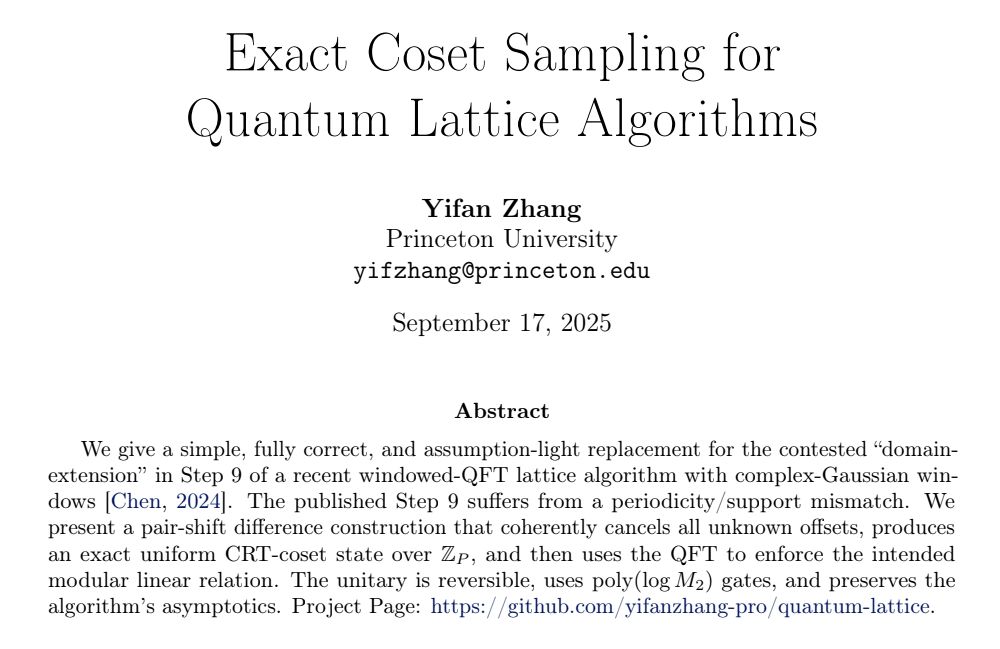
![Abstract. We present SALSAA, a more efficient and more versatile extension of the state-of-the-art lattice-based fully-succinct argument frameworks, “RoK, paper, SISsors (RPS)’’ and”RoK and Roll (RnR)’’ [Klooß, Lai, Nguyen, and Osadnik; ASIACRYPT’24, ’25], integrating the sumcheck technique as a main component. This integration enables us to design an efficient norm-check protocol (controlling the norm during witness extraction) with a strictly linear-time prover while reducing proof sizes by 2-3× compared to the previous quasi-linear-time norm-check in RPS/RnR, eliminating a central performance bottleneck. The sumcheck integration also allows us to natively support a wider class of relations, including rank-1 constraint systems (R1CS), which are widely used to express real-world computations.
To demonstrate the versatility and efficiency of our framework, we showcase three impactful applications achieved by different RoKs (Reductions of Knowledge) compositions: (i) a lattice-based succinct argument of knowledge with a linear-time prover, achieving a verifier time of 41 ms, prover runtime of 10.61 s, and proof size of 979 KB for a witness of 2²⁸ ℤ_(q) elements; (ii) a polynomial commitment scheme with matching performance; and (iii) the first lattice-based folding scheme natively operating on ℓ₂-norm-bounded witnesses, achieving highly efficient verification in 2.28 ms and producing a proof of just 73 KB for a witness of 2²⁸ Z_(q) elements, outperforming prior works for the family of linear relations.
We provide a modular, concretely efficient Rust implementation of our framework, benchmarked over cyclotomic rings with AVX-512-accelerated NTT-based arithmetic, demonstrating the practical efficiency of our approach.](https://cdn.bsky.app/img/feed_thumbnail/plain/did:plc:fwa55bujvdrwlwlwgqmmxmuf/bafkreie3czxdwa7a7s6wl2dqm5pciwxesfdtlab4qzfu63ifzmzkowufb4@jpeg)


![Abstract. We revisit the notion of Simulation Extractability (SE) for SNARKs in the updatable setting. We demonstrate that existing formal definitions of SE in this setting are insufficient to guarantee the required non-malleability in real-world scenarios. Towards this, we first identify and frame a malleability vulnerability: a cross-SRS reinterpretation attack, which shows that an adversary can reuse or maul proofs across different, correlated SRSs generated through the update procedure. This is made possible because existing security definitions fail to model an adversary’s ability to observe simulated proofs relative to various derived SRSs. To close this security gap, we propose a revised and stronger security notion of Updatable Simulation Extractability (USE) which was originally defined in [GKK+22]. Our definition models a dynamic environment where the SRS is adaptively updatable by the adversary, who can also query simulation oracles for proofs under the resulting family of reachable SRSs. This captures the full extent of the adversarial capabilities observed in practice. Finally, we provide positive results for popular polynomial-IOP-based SNARKs, and show that these schemes satisfy our stronger USE notion, provided the circuit-specific SRS is securely bound into the proof transcript, e.g., via a correct implementation of the Fiat-Shamir transformation.](https://cdn.bsky.app/img/feed_thumbnail/plain/did:plc:fwa55bujvdrwlwlwgqmmxmuf/bafkreihkpexhvlpgdg3ji43oxppvrbdy7nerkxwk32mmu2cbyawquewv2u@jpeg)


Time's short and they're counting on obscurity: please let German politicians know how horrifying their reversal would be.
Time's short and they're counting on obscurity: please let German politicians know how horrifying their reversal would be.



www.standaard.be/media-en-cul...
#ageverification #anonyimity #privacy

www.standaard.be/media-en-cul...
#ageverification #anonyimity #privacy
![Abstract. We resolve the Correlated Agreement (CA) problem for Reed-Solomon codes up to the information-theoretic capacity limit by introducing a fundamental change of basis: from the traditional evaluation domain to the syndrome space. Viewed through this “Syndrome-Space Lens,” the problem of proximity testing transforms into a transparent question of linear-algebraic geometry: a single affine line of syndromes traversing a family of low-dimensional subspaces. This new perspective makes a sharp phase transition at the capacity boundary visible, allowing for a complete characterization of the problem’s behavior across all parameter regimes, yielding short, self-contained proofs.
Classification. We establish a precise trichotomy organized by the rank margin Δ := t − d. At the capacity boundary (Δ = 0), the CA premise is information-theoretically vacuous, and we prove that no rigidity can be concluded without imposing additional structure. One step beyond capacity (Δ = 1), the problem enters a “knife-edge” regime where unconditional rigidity does not hold; soundness is recovered either through a combinatorial witness (such as a repeated error support or a small union of supports) or by adding protocol-level structure (such as independent two-fold MCA checks, DEEP/STIR out-of-domain sampling, or a global error locator). For stricter gaps (Δ ≥ 2), unconditional rigidity holds under a simple algebraic condition ((r + 1)k < m + 1), with explicit quantitative bounds.
MCA and Practical Implications. Below capacity (δ < 1 − ρ), the strengthened mutual correlated agreement (MCA) problem reduces to ordinary correlated agreement. MCA holds under the same hypotheses as CA. When folds are generated with independent challenges (e.g., via domain-separated Fiat-Shamir), the per-round security margins add. The model-scoped soundness law is Pr [FA] ≤ q^(−(∑Δ_(i))s), providing a clear and complete rulebook for selecting safe and efficient parameters in FRI/STARK systems. This work bypasses the complex machinery of list-decoding algorithms entirely and resolves the long-standing open problem concerning the gap between the Johnson bound and capacity.](https://cdn.bsky.app/img/feed_thumbnail/plain/did:plc:fwa55bujvdrwlwlwgqmmxmuf/bafkreiaayrmiiifnmnoz3wcuadq7bvpsx5eqo3o2zdw5jtjsbe6weofg2e@jpeg)



![Abstract. Succinct non-interactive arguments of knowledge (SNARKs) based on lattice assumptions offer a promising post-quantum alternative to pairing-based systems, but have until now suffered from inherently quadratic proof sizes in the security parameter. We introduce RoK and Roll, the first lattice-based SNARK that breaks the quadratic barrier, achieving communication complexity of Õ(λ) together with a succinct verification time. The protocol significantly improves upon the state of the art of fully-succinct argument systems established by “RoK, Paper, SISsors” (RPS) [ASIACRYPT’24] and hinges on two key innovations, presented as reductions of knowledge (RoKs): - Structured random projections: We introduce a new technique for structured random projections that allows us to reduce the witness dimensions while approximately preserving its ℓ₂ norm and maintaining the desired tensor structure. In order to maintain succinct communication and verification, the projected image is further committed and adjoined to the original relation. This procedure is recursively repeated until dimension of the intermediate witness becomes poly(λ), i.e. independent of the original witness length. - Unstructured random projection: When the witness is sufficiently small, we let the unstructured projection (over coefficients ℤ_(q)) be sent in plain, as in LaBRADOR [CRYPTO’23]. We observe, however, that the strategy from prior works to immediately lift the projection claim to ℛ_(q), and into our relation, would impose a quadratic communication cost. Instead, we gradually batch-and-lift the projection a the tower of intermediate ring extensions. This reduces the communication cost to Õ(λ) while maintaining a succinct verification time. These two techniques, combined with existing RoKs from RPS, yield a succinct argument system with communication complexity Õ(λ) and succinct verification for structured linear relations.](https://cdn.bsky.app/img/feed_thumbnail/plain/did:plc:fwa55bujvdrwlwlwgqmmxmuf/bafkreid4bm7u5l7gd3vcqxjis2acapv2mghcmlnouodjivp5bh3s6iynd4@jpeg)

Well you can't get everything I guess.
Well you can't get everything I guess.
If you want to be included, or nominate someone, see link in the replies!
If you want to be included, or nominate someone, see link in the replies!
(local groups work in cryptography, type theory, quantum algorithms, complexity theory, automata theory, error-correcting codes and lately also in database theory)
(local groups work in cryptography, type theory, quantum algorithms, complexity theory, automata theory, error-correcting codes and lately also in database theory)
arxiv.org/pdf/2509.02338

arxiv.org/pdf/2509.02338
Europe doubles down on research competitiveness with a major boost to #HorizonEurope:
€95.5 billion foreseen for 2021-2027
💰💰💰💰💰💰💰💰💰
€175 billion proposed for 2028-2034
💰💰💰💰💰💰💰💰💰💰💰💰💰💰💰💰💰💰
Europe doubles down on research competitiveness with a major boost to #HorizonEurope:
€95.5 billion foreseen for 2021-2027
💰💰💰💰💰💰💰💰💰
€175 billion proposed for 2028-2034
💰💰💰💰💰💰💰💰💰💰💰💰💰💰💰💰💰💰
www.nowpublishers.com/article/Book...

www.nowpublishers.com/article/Book...


We present a family of space-efficient sumcheck algorithms, and show that they are optimal! 🍹
Joint work with Anubhav, Ale, Elisabetta, @zkproofs.bsky.social, Tushar and Andrew
📚: ia.cr/2025/1473
🧑🏻💻: github.com/compsec-epfl...

We present a family of space-efficient sumcheck algorithms, and show that they are optimal! 🍹
Joint work with Anubhav, Ale, Elisabetta, @zkproofs.bsky.social, Tushar and Andrew
📚: ia.cr/2025/1473
🧑🏻💻: github.com/compsec-epfl...

giving.ucla.edu/Campaign/Donat
giving.ucla.edu/Campaign/Donat

